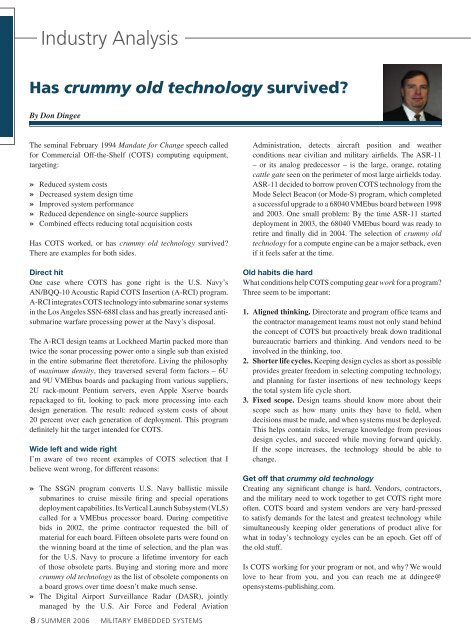Military Embedded Systems Summer 2006
Military Embedded Systems Summer 2006
Military Embedded Systems Summer 2006
Create successful ePaper yourself
Turn your PDF publications into a flip-book with our unique Google optimized e-Paper software.
Industry Analysis<br />
Has crummy old technology survived?<br />
By Don Dingee<br />
The seminal February 1994 Mandate for Change speech called<br />
for Commercial Off-the-Shelf (COTS) computing equipment,<br />
targeting:<br />
»<br />
»<br />
»<br />
»<br />
»<br />
Reduced system costs<br />
Decreased system design time<br />
Improved system performance<br />
Reduced dependence on single-source suppliers<br />
Combined effects reducing total acquisition costs<br />
Has COTS worked, or has crummy old technology survived?<br />
There are examples for both sides.<br />
Direct hit<br />
One case where COTS has gone right is the U.S. Navy’s<br />
AN/BQQ-10 Acoustic Rapid COTS Insertion (A-RCI) program.<br />
A-RCI integrates COTS technology into submarine sonar systems<br />
in the Los Angeles SSN-688I class and has greatly increased antisubmarine<br />
warfare processing power at the Navy’s disposal.<br />
The A-RCI design teams at Lockheed Martin packed more than<br />
twice the sonar processing power onto a single sub than existed<br />
in the entire submarine fleet theretofore. Living the philosophy<br />
of maximum density, they traversed several form factors – 6U<br />
and 9U VMEbus boards and packaging from various suppliers,<br />
2U rack-mount Pentium servers, even Apple Xserve boards<br />
repackaged to fit, looking to pack more processing into each<br />
design generation. The result: reduced system costs of about<br />
20 percent over each generation of deployment. This program<br />
definitely hit the target intended for COTS.<br />
Wide left and wide right<br />
I’m aware of two recent examples of COTS selection that I<br />
believe went wrong, for different reasons:<br />
»<br />
»<br />
The SSGN program converts U.S. Navy ballistic missile<br />
submarines to cruise missile firing and special operations<br />
deployment capabilities. Its Vertical Launch Subsystem (VLS)<br />
called for a VMEbus processor board. During competitive<br />
bids in 2002, the prime contractor requested the bill of<br />
material for each board. Fifteen obsolete parts were found on<br />
the winning board at the time of selection, and the plan was<br />
for the U.S. Navy to procure a lifetime inventory for each<br />
of those obsolete parts. Buying and storing more and more<br />
crummy old technology as the list of obsolete components on<br />
a board grows over time doesn’t make much sense.<br />
The Digital Airport Surveillance Radar (DASR), jointly<br />
managed by the U.S. Air Force and Federal Aviation<br />
Administration, detects aircraft position and weather<br />
conditions near civilian and military airfields. The ASR-11<br />
– or its analog predecessor – is the large, orange, rotating<br />
cattle gate seen on the perimeter of most large airfields today.<br />
ASR-11 decided to borrow proven COTS technology from the<br />
Mode Select Beacon (or Mode-S) program, which completed<br />
a successful upgrade to a 68040 VMEbus board between 1998<br />
and 2003. One small problem: By the time ASR-11 started<br />
deployment in 2003, the 68040 VMEbus board was ready to<br />
retire and finally did in 2004. The selection of crummy old<br />
technology for a compute engine can be a major setback, even<br />
if it feels safer at the time.<br />
Old habits die hard<br />
<br />
What conditions help COTS computing gear work for a program?<br />
<br />
Three seem to be important:<br />
1. Aligned thinking. Directorate and program office teams and<br />
<br />
the contractor management teams must not only stand behind<br />
<br />
the concept of COTS but proactively break down traditional<br />
<br />
bureaucratic barriers and thinking. And vendors need to be<br />
involved in the thinking, too.<br />
<br />
2. Shorter life cycles. Keeping design cycles as short as possible<br />
<br />
provides greater freedom in selecting computing technology,<br />
and planning for faster insertions of new technology keeps<br />
the total system life cycle short.<br />
3. Fixed scope. Design teams should know more about their<br />
scope such as how many units they have to field, when<br />
decisions must be made, and when systems must be deployed.<br />
This helps contain risks, leverage knowledge from previous<br />
design cycles, and succeed while moving forward quickly.<br />
If the scope increases, the technology should be able to<br />
change.<br />
Get off that crummy old technology<br />
Creating any significant change is hard. Vendors, contractors,<br />
and the military need to work together to get COTS right more<br />
often. COTS board and system vendors are very hard-pressed<br />
to satisfy demands for the latest and greatest technology while<br />
simultaneously keeping older generations of product alive for<br />
what in today’s technology cycles can be an epoch. Get off of<br />
the old stuff.<br />
Is COTS working for your program or not, and why? We would<br />
love to hear from you, and you can reach me at ddingee@<br />
opensystems-publishing.com.<br />
<br />
/ SUMMER <strong>2006</strong><br />
<strong>Military</strong> EMBEDDED SYSTEMS
















